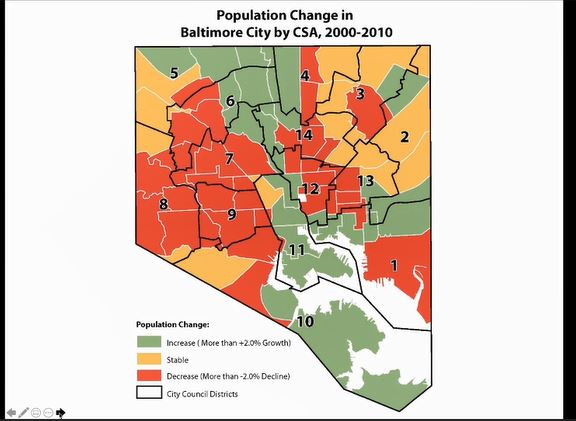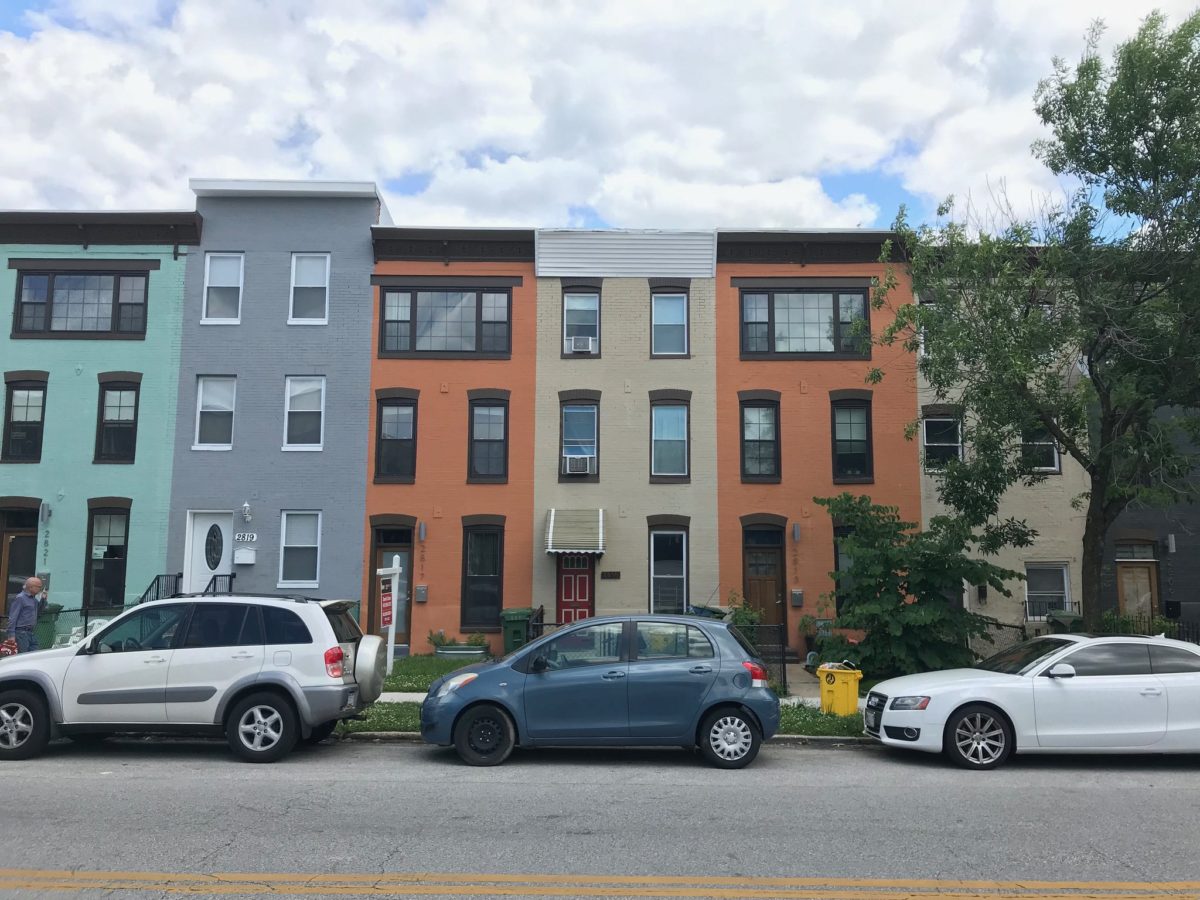To understand Baltimore’s population trends, look to the neighborhood level.
That was on view Tuesday at one of the first sessions of Baltimore Innovation Week 2021. Seema Iyer, who oversees the Baltimore Neighborhood Indicators Alliance (BNIA) at the University of Baltimore’s Jacob France Institute, led a workshop using the Vital Signs 19 report. The annual report from BNIA uses civic data to look at the health of Baltimore’s neighborhoods.
The session was geared toward business owners, and focused on three topic areas of the report: Workforce and economic development, housing and community development, and crime and safety.
Some of the data was stark in its depiction of the health of Baltimore. Population data set the stage.

Population change, 2000-2010 (Screenshot via Baltimore Neighborhood Indicators Alliance)
While data from the 2020 U.S. Census is still coming in, the most recent annual estimates show the city is losing population, keeping with a trend that was true in the data from the 2000-2010 Census. A slide showed that Baltimore’s population fell by 5% from 2000-2010, in contrast to other nearby cities.
“This is our existential problem,” said Iyer. “We are the only East Coast city in that I-95 corridor megalopolis region that is continuing to lose population,” she said.
BNIA, Iyer said, is an organization that seeks to put that city data in a neighborhood context. On a neighborhood level, as has often been talked about in reports and critiques of the city, it’s a tale of two Baltimores — a city of haves and have nots, a White L and a Black butterfly. There are neighborhoods that are growing and stable, while others are declining.
“When you start to lose population in a city like ours, you start to lose everything else in that bundle of goods a neighborhood can provide,” Iyer said. “That becomes a vicious cycle. Once you start to lose, you continue to lose.”

Population change in Baltimore, 2000-2010 (Screenshot via Baltimore Neighborhood)
The key to noticing all of these problems within the data is recognizing that it allows communities to accurately find solutions. Data has shown that 2020 had Baltimore’s lowest level of residential vacancy, per Vital Signs. Vacancy, or the percentage of residential homes that are unoccupied in a neighborhood, is a great indicator of whether a neighborhood is growing or declining. Increased funding and investment in rehabilitation of houses correlates with fewer vacancies. That’s data that could lead to a possible solution to some of these issues.

Vacant and abandoned properties in Baltimore. (Screenshot via BNIA)
And from the data, Iyer found that connectedness was the missing link between neighborhoods that grew, and those that didn’t.
“Every neighborhood that had access to our mobility system, which right now unfortunately is our highway system, has grown,” said Iyer. “Connectivity is all about that thickness of markets. Some of our neighborhoods don’t have all of the permutations that a node of connectivity can yield.”
Donte Kirby is a 2020-2022 corps member for Report for America, an initiative of The Groundtruth Project that pairs young journalists with local newsrooms. This position is supported by the Robert W. Deutsch Foundation.Before you go...
Please consider supporting Technical.ly to keep our independent journalism strong. Unlike most business-focused media outlets, we don’t have a paywall. Instead, we count on your personal and organizational support.
3 ways to support our work:- Contribute to the Journalism Fund. Charitable giving ensures our information remains free and accessible for residents to discover workforce programs and entrepreneurship pathways. This includes philanthropic grants and individual tax-deductible donations from readers like you.
- Use our Preferred Partners. Our directory of vetted providers offers high-quality recommendations for services our readers need, and each referral supports our journalism.
- Use our services. If you need entrepreneurs and tech leaders to buy your services, are seeking technologists to hire or want more professionals to know about your ecosystem, Technical.ly has the biggest and most engaged audience in the mid-Atlantic. We help companies tell their stories and answer big questions to meet and serve our community.
Join our growing Slack community
Join 5,000 tech professionals and entrepreneurs in our community Slack today!

The person charged in the UnitedHealthcare CEO shooting had a ton of tech connections

From rejection to innovation: How I built a tool to beat AI hiring algorithms at their own game

Where are the country’s most vibrant tech and startup communities?



